One and a Half Meals Per Day OAAHM Keto
Switching to one meal a day (OMAD) can feel like a big leap, presenting some changes to your eating routine. Many find the transition challenging, but manageable with proper planning.
With some solid OMAD transition tips, you can be on your way to success.
You might wonder how to handle such a significant shift in your eating pattern, possibly involving changes in timing or quantity consumed.
This article focuses on easing that shift. We'll explore moving to one meal and a half (O-A-A-H-M) per day instead of immediately restricting to just one meal.
Easing Into OMAD: The One-And-A-Half Meal Approach
The direct jump to OMAD can be overwhelming. Consuming all your daily calories and nutrients in one sitting isn't for everyone.
That sudden change can cause discomfort for some individuals and lead to digestive issues. Instead of jumping directly into OMAD, consider trying one and a half meals a day.
This approach simplifies the adjustment process. It allows your digestive system to adapt more comfortably and reduce inflammation.

How O-A-A-H-M Works
With this approach, you're not restricting your intake. You're delaying it, effectively spacing out your eating without severely cutting calories. This approach may also assist with maintaining better blood sugar levels.
You consume a larger portion of your daily food intake around 1 PM. Then, you follow it with a smaller, lighter meal around 6 PM, fitting within a roughly 5-hour eating window, thus giving your body about 19 hours to rest and repair. This will get you close to the 20-hour fasting period.
This method provides the health benefits of fasting. It also lessens the stress of fitting everything into a large meal. Splitting the meal also aids digestion by giving your digestive system a more manageable workload while supporting gut health.
Structuring Your Meals for Success
The first meal, around 1 PM, should be satisfying and protein-focused. Consider options like hard-boiled eggs, berries, nuts, seeds, or hummus. These options are very satiating, so they may help to reduce cravings later.
Five hours later, enjoy a large salad and your remaining items. This meal is primarily fiber, which minimally impacts insulin levels. Prioritize vegetables for this main meal.
Adding healthy fats and a keto dessert completes the meal without leaving you feeling deprived. Keto fat bombs, packed with healthy fats, offer a way to keep energy high.
Incorporating these elements can also potentially aid in burning fat more efficiently. Here's some data to illustrate this:
The O-A-A-H-M approach's flexibility allows for variation, but results may differ, possibly needing some experimentation. Adjust foods based on your personal results. The benefits listed below may be obtained.
Easier transition to a restricted time-restricted feeding window.
Allows for consuming all meals socially with family.
A nearly 20-hour fasting period.
Supports sufficient calorie and nutrient intake, split for better absorption and thus promoting cellular renewal.
Potentially improves digestive health by reducing the strain of large meal sizes.
May improve satiety through this structured eating pattern.
Reduces the impact on insulin release compared to consuming all food in one sitting.
Optimizing Nutrient Intake on O-A-A-H-M
With an intermittent approach, strategic planning is critical for nutrition. These factors are intertwined, so you will need to consider that. Focus on high-quality protein, healthy fats, and plenty of greens.
For a detailed nutritional overview, consult the USDA's dietary guidelines. Their reports provide in-depth analysis. However, generally following these guidelines helps with planning, which can increase human growth hormone.

OMAD Transition Tips – Nutrition Guide
Protein (Build Muscle Mass)
First Meal (1 PM): Chicken breast, salmon, or tofu.
Second Meal (6 PM): Add lentils or a small portion of lean meat.
Healthy Fats (Energy & Brain Function)
First Meal (1 PM): Avocado or a handful of nuts.
Second Meal (6 PM): Olive oil dressing on salad or seeds.
Fiber (Digestive & Gut Health)
First Meal (1 PM): Berries.
Second Meal (6 PM): A large salad with mixed greens.
Micronutrients (Overall Wellness)
First Meal (1 PM): A mix of fruits and vegetables.
Second Meal (6 PM): Various leafy greens.
Micronutrients are crucial for overall wellness and contribute to various bodily functions, including increased autophagy. Autophagy helps to remove dead cells from your body, contributing to health improvements.
A balanced intake of micronutrients can help with things such as, reduced cancer risk and also decreased disease risks.
Making Adjustments to Your OMAD Transition
Everyone's body reacts differently to dietary changes. Adjusting meal content based on biofeedback is very helpful, especially if you have any chronic health issues. Transition tips often highlight the need for adaptation over time.
Keep in mind that changing anything drastically can cause issues. It is much better to make incremental adjustments to your meal plan. Aim to change one small variable every two weeks.
Remember that dietary changes, especially significant ones like OMAD, can interact with medications. Be cautious and make sure to avoid potentially harmful drug interactions.
You do not want any type of issues, especially if it related to a medical condition
Planning Satisfying Meals to Support Your OMAD Transition
Transitioning to One Meal a Day (OMAD) requires more than simply reducing meal frequency; it involves thoughtful planning to ensure you meet your nutritional needs within a single sitting.
A well-balanced OMAD meal should include high-quality proteins, healthy fats, and nutrient-dense vegetables to provide sustained energy and promote satiety.
For instance, preparing a comforting dish like chicken pot pie with a keto-friendly crust can be a delicious and satisfying way to incorporate essential nutrients while keeping carb intake low.
By using almond flour or coconut flour for the crust and adding plenty of protein-rich chicken and fiber-filled vegetables, you create a meal that supports muscle maintenance and digestive health.
Including healthy fats such as butter or cream ensures you stay full longer, reducing the likelihood of cravings later. Thoughtful meal choices like this make the OMAD transition smoother while helping you stay energized throughout the day.
Conclusion
These OMAD transition tips offer a way to adapt gradually, which will increase the health benefits. It might be worthwhile to start, even if it initially deviates from your usual eating pattern.
Sticking to healthy meals is also crucial to obtaining good results, as the OMAD diet isn't magical.
The O-A-A-H-M approach is an actionable starting point. You gain the ability to achieve long-term success by using these small tips, by easing in slowly so that your body isn't under stress.
Personalizing your plan through gradual adjustments, focusing on your own situation will help and what you can do with your daily eating habits; also, accounting for the times that you aren't eating will allow your metabolic health to get stronger by encouraging the burning fat capabilities of your body.
FAQs about OMAD transition tips
How to transition to the OMAD diet?
Start gradually by eating one and a half meals per day (O-A-A-H-M). Consume a protein-heavy meal first, then a lighter, fiber-rich meal later, you'll eat healthy using this split.
How long until your body gets used to OMAD?
It varies, but easing in with O-A-A-H-M helps some people adjust within a few weeks. Listen to your body and adapt by noting your biofeedback markers, especially during a longer fast.
Also you want to take into account your activity level for best results.
What are the four rules of OMAD?
While there aren't four official rules, success depends on meal timing. Focus on nutrition, and adjust based on your feelings. Consider using bone broth during fasting periods for added nutrients.
Does OMAD heal your gut?
Giving your digestive system an extended rest can support gut health. The O-A-A-H-M method helps to create positive changes when aiming for OMAD and may improve blood flow.
Fasting includes all types, such as intermittent fasting and intuitive fasting.
Previous blog
The Benefits of Plank ExercisesTags

Popular
08/21/2024
55.7K views
02/23/2025
46.8K views
11/18/2024
281.2K views
03/18/2024
11/21/2022




